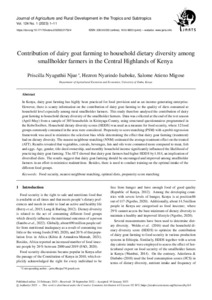| dc.date.accessioned | 2023-02-24T09:27:21Z | |
| dc.date.available | 2023-02-24T09:27:21Z | |
| dc.date.issued | 2023-02-21 | |
| dc.identifier | doi:10.17170/kobra-202302217524 | |
| dc.identifier.uri | http://hdl.handle.net/123456789/14439 | |
| dc.language.iso | eng | eng |
| dc.rights | Namensnennung 4.0 International | * |
| dc.rights.uri | http://creativecommons.org/licenses/by/4.0/ | * |
| dc.subject | food security | eng |
| dc.subject | nearest neighbour matching | eng |
| dc.subject | optimal diets | eng |
| dc.subject | propensity score matching | eng |
| dc.subject.ddc | 300 | |
| dc.subject.ddc | 630 | |
| dc.title | Contribution of dairy goat farming to household dietary diversity among smallholder farmers in the Central Highlands of Kenya | eng |
| dc.type | Aufsatz | |
| dcterms.abstract | In Kenya, dairy goat farming has highly been practiced for food provision and as an income-generating enterprise. However, there is scanty information on the contribution of dairy goat farming to the quality of diets consumed at household level especially among rural smallholder farmers. This study therefore analysed the contribution of dairy goat farming to household dietary diversity of the smallholder farmers. Data was collected at the end of the wet season (April-May) from a sample of 385 households in Kirinyaga County, using structured questionnaires programmed in the KoboToolbox. Household dietary diversity scores (HDDS) were used as a measure for food security, where 12 food groups commonly consumed in the area were considered. Propensity to score matching (PSM) with a probit regression framework was used to minimize the selection bias while determining the effect that dairy goat farming (treatment) had on dietary diversity. The nearest neighbour matching (NNM) estimated the average treatment effect on the treated (ATT). Results revealed that vegetables, cereals, beverages, fats and oils were consumed more compared to meat, fish and eggs. Age, gender, title deed ownership, and monthly household income significantly influenced the likelihood of practicing dairy goat farming. The ATT showed that dairy goat farmers had higher HDDS by 1.014, an implication of diversified diets. The results suggest that dairy goat farming should be encouraged and improved among smallholder farmers in an effort to minimize malnutrition. Besides, there is need to conduct training on the optimal intake of the different food groups. | eng |
| dcterms.accessRights | open access | |
| dcterms.creator | Njue, Priscilla Nyaguthii | |
| dcterms.creator | Isaboke, Hezron Nyarindo | |
| dcterms.creator | Migose, Salome Atieno | |
| dc.subject.swd | Kenia | ger |
| dc.subject.swd | Milchziege | ger |
| dc.subject.swd | Ziegenhaltung | ger |
| dc.subject.swd | Kleinbauer | ger |
| dc.subject.swd | Ernährungssicherung | ger |
| dc.subject.swd | Ernährung | ger |
| dc.subject.swd | Vielfalt | ger |
| dc.type.version | publishedVersion | |
| dcterms.source.identifier | eissn:2363-6033 | |
| dcterms.source.issue | No. 1 | |
| dcterms.source.journal | Journal of Agriculture and Rural Development in the Tropics and Subtropics (JARTS) | eng |
| dcterms.source.pageinfo | 1-11 | |
| dcterms.source.volume | Vol. 124 | |
| kup.iskup | false | |


